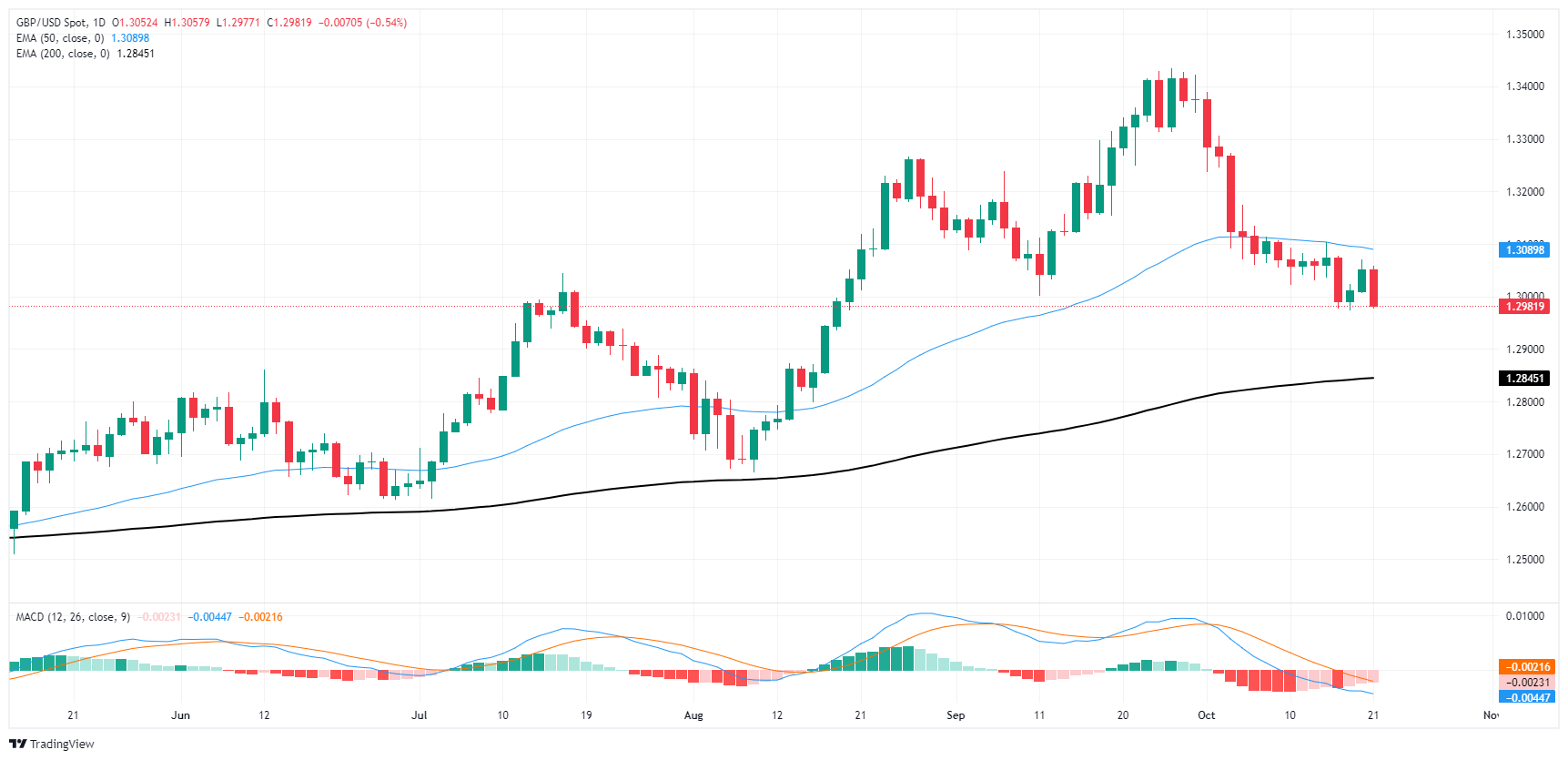GBP/USD slips back below 1.30 on Monday’s Greenback bounce


- GBP/USD shed half of a percent as the Pound’s recovery against the US Dollar abruptly ends.
- Looming BoE appearances and global PMI figures to keep Pound momentum capped this week.
- Investors bucked on Monday after Fed officials cautioned that the pace of rate cuts may slow.
GBP/USD twisted into the low side on Monday, kicking off the new trading week with a fresh test south of the 1.3000 handle as Cable traders balk ahead of a hectic week that sees a slew of appearances from central bank figures, as well as an update on global Purchasing Managers Index (PMI) figures.
Pound Sterling traders will be keeping an eye out for an appearance from Bank of England (BoE) Governor Andrew Bailey on Tuesday. However, the BoE head’s comments will be coming much later in the day as Bailey will be delivering speech notes at the Bloomberg Global Regulatory Forum in New York during the early US market session.
Global PMI figures are slated for a rolling release on Thursday, with UK figures kicking off the Cable docket. Median market forecasts are expecting a slight downtick in UK activity numbers, with October’s Services PMI specifically expected to ease to 52.2 from 52.4 the previous month.
GBP/USD price forecast
The GBP/USD pair continues to trade with a bearish bias, currently hovering near 1.2982 after failing to hold above the 1.3000 psychological level. The price is trading below the 50-day EMA at 1.3089, signaling that the bears are in control of the short-term trend. The next key support lies at 1.2845, where the 200-day EMA resides, offering potential downside protection. If sellers maintain pressure, a break below this long-term support could accelerate further losses towards 1.2800.
The MACD indicator paints a weak picture, with the histogram showing expanding negative momentum as the MACD line remains below the signal line, reinforcing the bearish outlook. Bulls are struggling to regain traction, and the pair's failure to break above the 50-day EMA adds to the downside risks. A daily close below 1.2900 could further confirm the bearish sentiment, while a bounce back above 1.3100 is needed to restore the pair's upside potential.
GBP/USD daily chart
Pound Sterling FAQs
What is the Pound Sterling?
The Pound Sterling (GBP) is the oldest currency in the world (886 AD) and the official currency of the United Kingdom. It is the fourth most traded unit for foreign exchange (FX) in the world, accounting for 12% of all transactions, averaging $630 billion a day, according to 2022 data. Its key trading pairs are GBP/USD, also known as ‘Cable’, which accounts for 11% of FX, GBP/JPY, or the ‘Dragon’ as it is known by traders (3%), and EUR/GBP (2%). The Pound Sterling is issued by the Bank of England (BoE).
How do the decisions of the Bank of England impact on the Pound Sterling?
The single most important factor influencing the value of the Pound Sterling is monetary policy decided by the Bank of England. The BoE bases its decisions on whether it has achieved its primary goal of “price stability” – a steady inflation rate of around 2%. Its primary tool for achieving this is the adjustment of interest rates. When inflation is too high, the BoE will try to rein it in by raising interest rates, making it more expensive for people and businesses to access credit. This is generally positive for GBP, as higher interest rates make the UK a more attractive place for global investors to park their money. When inflation falls too low it is a sign economic growth is slowing. In this scenario, the BoE will consider lowering interest rates to cheapen credit so businesses will borrow more to invest in growth-generating projects.
How does economic data influence the value of the Pound?
Data releases gauge the health of the economy and can impact the value of the Pound Sterling. Indicators such as GDP, Manufacturing and Services PMIs, and employment can all influence the direction of the GBP. A strong economy is good for Sterling. Not only does it attract more foreign investment but it may encourage the BoE to put up interest rates, which will directly strengthen GBP. Otherwise, if economic data is weak, the Pound Sterling is likely to fall.
How does the Trade Balance impact the Pound?
Another significant data release for the Pound Sterling is the Trade Balance. This indicator measures the difference between what a country earns from its exports and what it spends on imports over a given period. If a country produces highly sought-after exports, its currency will benefit purely from the extra demand created from foreign buyers seeking to purchase these goods. Therefore, a positive net Trade Balance strengthens a currency and vice versa for a negative balance.








